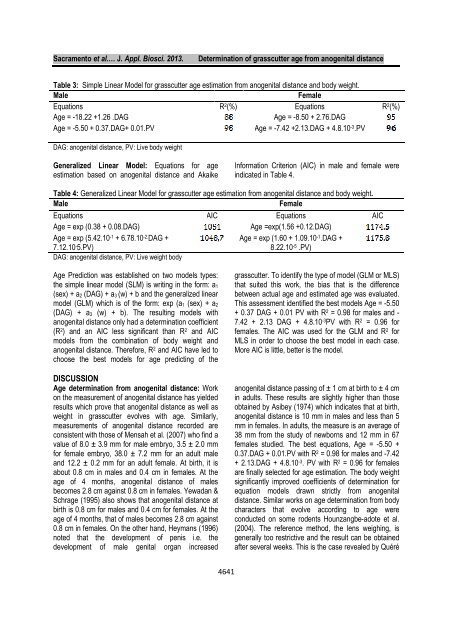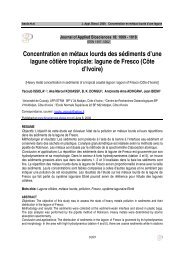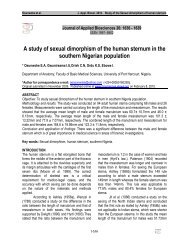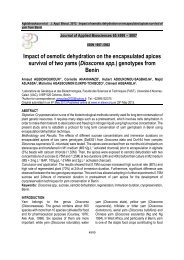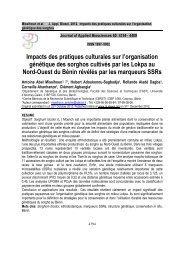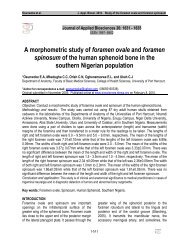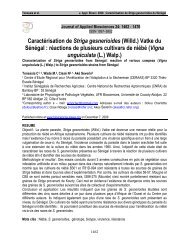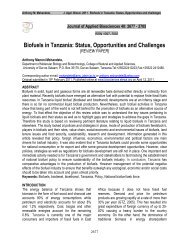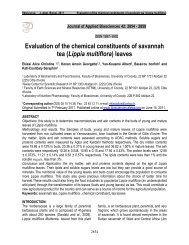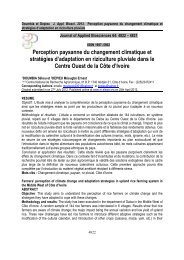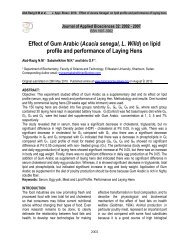Sacramento et al.… J. Appl. Biosci. 2013.<strong>Determination</strong> <strong>of</strong> <strong>grasscutter</strong> <strong>age</strong> from anogenital distance• sheets for recording measured data.Manual restraint <strong>of</strong> <strong>grasscutter</strong>: Before anymeasurement, the animals were manually restrained.This manual restraint has been shown by Mensah &Ekué, (2003) and Mensah et al., (2007):• seize the animal almost at the base <strong>of</strong> the tail;• raise its hindquarters so that only the frontlegs are resting on the floor <strong>of</strong> the block• Then, slowly, carefully lift it completely fromthe ground making sure it does not turn on itself,because in this case the tail may dislocate and break.Once the animal content, it was introduced into theburlap bag and hung on the spring scale to gain weight.Measurement <strong>of</strong> anogenital distance: Themeasurement <strong>of</strong> anogenital distance involved all<strong>grasscutter</strong>s <strong>of</strong> all <strong>age</strong>s and sexes. For the success <strong>of</strong>this operation, three persons were used. In addition,disinfection <strong>of</strong> the caliper should be careful done toavoid transmission <strong>of</strong> diseases from one animal toanother. The measurement was made from smaller tolarger. Operations, which were repeated three times,took place as follows:• contention <strong>grasscutter</strong> supine;• installation <strong>of</strong> the caliper between the upperend <strong>of</strong> the anus and the lower end <strong>of</strong> the vulva;• Paired reading distance for accuracy.The measurements <strong>of</strong> a rodent’s anogenital distance,applied to <strong>grasscutter</strong>s, were performed following themethod inspired by Rosevear (1969) and used bySicard et al. (1995). To perform these measurements,the <strong>grasscutter</strong> was lying on its back and its headfacing the left side. This allowed easy access tomeasurements on the same side and at different <strong>age</strong>sas follows: 2 weeks, 4 weeks, 8 weeks, 12 weeks, 16weeks, 20 weeks, 24 weeks, 28 weeks, 32 weeks, 36weeks, 40 weeks, 44 weeks and 48 weeks at afrequency <strong>of</strong> once a week. 5 to 10 min after anesthesia,<strong>grasscutter</strong>s were removed from the c<strong>age</strong> and installedfor linear measurements and body weight.Method <strong>of</strong> anesthesia <strong>of</strong> the <strong>grasscutter</strong>: Once theweighing was completed, the <strong>grasscutter</strong> was taken out<strong>of</strong> the bag and then introduced into the restraining c<strong>age</strong>where it was anesthetized. Using 2 ml short syringes,RESULTSSimple Linear Model: Equations for <strong>age</strong> estimationbased on anogenital distance and coefficient <strong>of</strong>small diameter and single-use needles, a mixture <strong>of</strong>equal volumes <strong>of</strong> xylazine hydrochloride (Rompun 2%ND) and ketamine hydrochloride (Imalgene 1000 ND ) wasused in the same syringe at a dose <strong>of</strong> 0.1 ml / kg bodyweight. This method for anesthetizing <strong>grasscutter</strong> wasindicated by Adjanohoun (1986) and Farougou (1992)because the two products used separately are poorlytolerated by this rodent (Adjanohoun, 1988). On thebasis <strong>of</strong> animal body weight, the dose injected in eachanimal was calculated. This mixture injectedintramuscularly (IM) at the base <strong>of</strong> the tail, yielded agood sedation with excellent muscle relaxation at lowdoses. Anesthesia was effective after 5 to 10 minutesand the <strong>grasscutter</strong> slept for 30 to 60 minutes before itseffect wore <strong>of</strong>f. This time was sufficient to take all linearmeasurements on the animal. All measurements weretaken early morning before feeding to avoid skewingthe data and frequency <strong>of</strong> once a week. Pregnantfemales were excluded from the study.Statistical analyses: The collected data were entered,coded and recorded using the Excel 2007 before beingprocessed. Descriptive statistics were performed. Thepairwise comparisons <strong>of</strong> means were performed usingStudent's test. The relationship between <strong>age</strong>s andvarious body measurements and weight weredetermined by calculating the correlation matrixbetween variables. This correlation provided guidanceon the simultaneous evolution <strong>of</strong> the variables taken inpairs. The coefficients <strong>of</strong> determination (R 2 ) for the MLSand the Akaike Information Criterion (AIC) for the MLGwere used to identify the best equation models. Forestablishing prediction equations, it was the simplelinear model (SLM) and the generalized linear model(GLM) that were used. In general, a predictive model isany equation that can be put in the form <strong>of</strong>: y = ax + b,with y the dependent variable, b the value <strong>of</strong> y when x =0; a change <strong>of</strong> y for any change in a unit <strong>of</strong> x, and x isthe independent variable. Once developed, thesemodels were used from independent samples. For dataprocessing we used the s<strong>of</strong>tware R 2.10.0 with lots <strong>of</strong>pack<strong>age</strong>s (MASS, FactoMineR,).determination R 2 (%) in male and female were indicatedin Table 3.4640
Sacramento et al.… J. Appl. Biosci. 2013.<strong>Determination</strong> <strong>of</strong> <strong>grasscutter</strong> <strong>age</strong> from anogenital distanceTable 3: Simple Linear Model for <strong>grasscutter</strong> <strong>age</strong> estimation from anogenital distance and body weight.MaleFemaleEquations R 2 (%) Equations R 2 (%)Age = -18.22 +1.26 .DAGAge = -8.50 + 2.76.DAGAge = -5.50 + 0.37.DAG+ 0.01.PVAge = -7.42 +2.13.DAG + 4.8.10 -3 .PVDAG: anogenital distance, PV: Live body weightGeneralized Linear Model: Equations for <strong>age</strong>estimation based on anogenital distance and AkaikeInformation Criterion (AIC) in male and female wereindicated in Table 4.Table 4: Generalized Linear Model for <strong>grasscutter</strong> <strong>age</strong> estimation from anogenital distance and body weight.MaleFemaleEquations AIC Equations AICAge = exp (0.38 + 0.08.DAG)Age =exp(1.56 +0.12.DAG)Age = exp (5.42.10 -1 + 6.78.10 -2. DAG +7.12.10 - 5.PV)Age = exp (1.60 + 1.09.10 -1 .DAG +8.22.10 -5 .PV)DAG: anogenital distance, PV: Live weight bodyAge Prediction was established on two models types:the simple linear model (SLM) is writing in the form: a 1(sex) + a 2 (DAG) + a 3 (w) + b and the generalized linearmodel (GLM) which is <strong>of</strong> the form: exp (a 1 (sex) + a 2(DAG) + a 3 (w) + b). The resulting models withanogenital distance only had a determination coefficient(R 2 ) and an AIC less significant than R 2 and AICmodels from the combination <strong>of</strong> body weight andanogenital distance. Therefore, R 2 and AIC have led tochoose the best models for <strong>age</strong> predicting <strong>of</strong> theDISCUSSIONAge determination from anogenital distance: Workon the measurement <strong>of</strong> anogenital distance has yieldedresults which prove that anogenital distance as well asweight in <strong>grasscutter</strong> evolves with <strong>age</strong>. Similarly,measurements <strong>of</strong> anogenital distance recorded areconsistent with those <strong>of</strong> Mensah et al. (2007) who find avalue <strong>of</strong> 8.0 ± 3.9 mm for male embryo, 3.5 ± 2.0 mmfor female embryo, 38.0 ± 7.2 mm for an adult maleand 12.2 ± 0.2 mm for an adult female. At birth, it isabout 0.8 cm in males and 0.4 cm in females. At the<strong>age</strong> <strong>of</strong> 4 months, anogenital distance <strong>of</strong> malesbecomes 2.8 cm against 0.8 cm in females. Yewadan &Schr<strong>age</strong> (1995) also shows that anogenital distance atbirth is 0.8 cm for males and 0.4 cm for females. At the<strong>age</strong> <strong>of</strong> 4 months, that <strong>of</strong> males becomes 2.8 cm against0.8 cm in females. On the other hand, Heymans (1996)noted that the development <strong>of</strong> penis i.e. thedevelopment <strong>of</strong> male genital organ increased<strong>grasscutter</strong>. To identify the type <strong>of</strong> model (GLM or MLS)that suited this work, the bias that is the differencebetween actual <strong>age</strong> and estimated <strong>age</strong> was evaluated.This assessment identified the best models Age = -5.50+ 0.37 DAG + 0.01 PV with R 2 = 0.98 for males and -7.42 + 2.13 DAG + 4.8.10 -3 PV with R 2 = 0.96 forfemales. The AIC was used for the GLM and R 2 forMLS in order to choose the best model in each case.More AIC is little, better is the model.anogenital distance passing <strong>of</strong> ± 1 cm at birth to ± 4 cmin adults. These results are slightly higher than thoseobtained by Asibey (1974) which indicates that at birth,anogenital distance is 10 mm in males and less than 5mm in females. In adults, the measure is an aver<strong>age</strong> <strong>of</strong>38 mm from the study <strong>of</strong> newborns and 12 mm in 67females studied. The best equations, Age = -5.50 +0.37.DAG + 0.01.PV with R 2 = 0.98 for males and -7.42+ 2.13.DAG + 4.8.10 -3 . PV with R 2 = 0.96 for femalesare finally selected for <strong>age</strong> estimation. The body weightsignificantly improved coefficients <strong>of</strong> determination forequation models drawn strictly from anogenitaldistance. Similar works on <strong>age</strong> determination from bodycharacters that evolve according to <strong>age</strong> wereconducted on some rodents Hounzangbe-adote et al.(2004). The reference method, the lens weighing, isgenerally too restrictive and the result can be obtainedafter several weeks. This is the case revealed by Quéré4641


